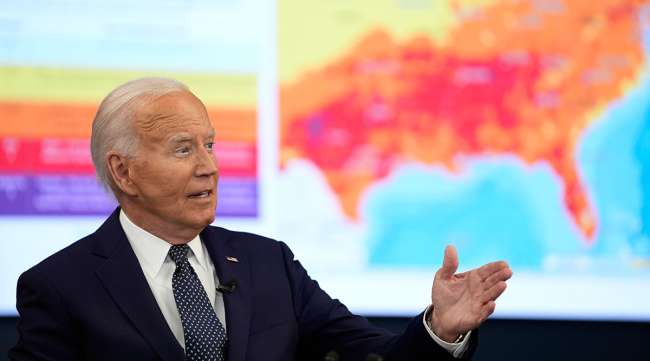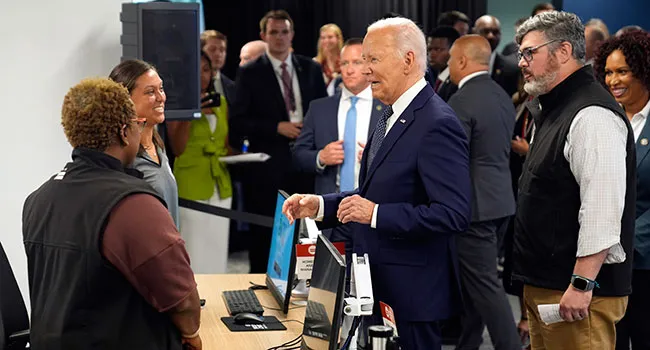Associated Press
Biden Proposes Rule to Protect Workers From Extreme Heat

[Stay on top of transportation news: Get TTNews in your inbox.]
WASHINGTON — President Joe Biden on July 2 proposed a new rule to address excessive heat in the workplace, warning — as tens of millions of people in the U.S. are under heat advisories — that high temperatures are the country’s leading weather-related killer.
If finalized, the measure would protect an estimated 36 million U.S. workers from injuries related to heat exposure on the job — establishing the first major federal safety standard of its kind. Those affected by excessive heat in the workplace include farmworkers, delivery and construction workers, landscapers and indoor workers in warehouses, factories and kitchens.
Biden highlighted the proposed rule as one of five steps his Democratic administration is taking to address extreme weather as Hurricane Beryl is already ripping through the Caribbean in an ominous sign for the summer.
Biden used his remarks at the DC Emergency Operations Centers to blast those Republican lawmakers who deny the existence of climate change, saying, “It’s not only outrageous, it’s really stupid.” Biden noted that there are human and financial costs from climate change, saying that weather-inflicted damage last year cost the economy $90 billion.
“More people die from extreme heat than floods, hurricanes and tornadoes combined,” Biden said. “These climate-fueled extreme weather events don’t just affect people’s lives. They also cost money. They hurt the economy, and they have a significant negative psychological effect on people.”

Biden greets people during a visit to the DC Emergency Operations Center. (Evan Vucci/Associated Press)
The Democratic president, who’s seeking re-election in part on his environmental record, said the Federal Emergency Management Agency also was finalizing a rule to factor in possible flooding risks for federal construction projects.
Also, FEMA was announcing $1 billion in grants to help communities deal with natural disasters, while the Environmental Protection Agency was releasing a new report on climate change’s impacts. Lastly, Biden said his administration would hold a conference titled “White House Summer on Extreme Heat” in the coming months.
Despite increased awareness of the risks posed to human health by high temperatures, extreme heat protections — for those routinely exposed to heat index readings above 80 degrees Fahrenheit — have lagged.
“The purpose of this rule is simple,” a senior White House administration official told reporters. “It is to significantly reduce the number of worker-related deaths, injuries and illnesses suffered by workers who are exposed to excessive heat ... while simply doing their jobs.”

Staff members listen as Biden speaks. (Evan Vucci/Associated Press)
Under the proposed rule, employers would be required to identify heat hazards, develop emergency response plans related to heat illness, and provide training to employees and supervisors on the signs and symptoms of such illnesses. They would also have to establish rest breaks, provide shade and water, and heat acclimatization — or the building of tolerance to higher temperatures — for new workers.
Penalties for heat-related violations in workplaces would increase significantly, in line with what workplaces are issued for violations of Occupational Safety and Health Administration rules, a senior White House administration official said.
An estimated 2,300 people in the U.S. died from heat-related illness in 2023. Workers with prolonged exposure to extreme heat are among the most vulnerable to related health risks, such as heatstroke and other illnesses, according to the Centers for Disease Control and the National Oceanic and Atmospheric Administration.
The makers of Transport Topics' updated Top 100 For-Hire Carriers list examine how the freight market slump has altered the competitive landscape in trucking. Tune in above or by going to RoadSigns.ttnews.com.
As the hottest month of the year gets underway, millions of Americans will be at greater risk of heat strokes, dangerous dehydration and heat-related heart stress.
The Labor Department has been developing a standard for how workplaces deal with heat since 2021, with OSHA having held meetings last year to hear about how the proposed measures could affect small businesses.
The AFL-CIO union federation praised the Biden administration’s rule. “If finalized, this new rule would address some of the most basic needs for workers’ health and safety,” AFL-CIO President Liz Shuler said.
Heat protection laws in the U.S. have faced steady industry opposition, including from chambers of commerce and other business associations. Many say a blanket mandate would be difficult to implement across such a wide range of industries.
California, Colorado, Oregon, Minnesota and Washington are the only states with workplace standards for heat exposure. Some regulations have recently come under attack by Republicans. Over the past year, Florida and Texas, led by Gov. Ron DeSantis and Gov. Greg Abbott, both Republicans, passed legislation preventing local governments from requiring heat protections for outdoor workers.
If finalized, the Biden administration’s rule would override state measures, and states with existing procedures to deal with heat would have to institute measures that are at least as stringent as the finalized federal rule.
Want more news? Listen to today's daily briefing below or go here for more info:





